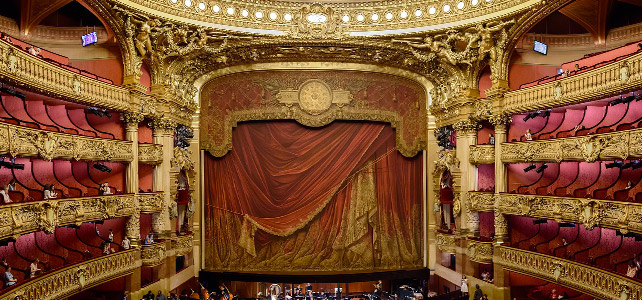 Opera was born in Italy. The Latin word translates to “work” in english and is a performance with all of the words sung to orchestral accompaniment. Italian opera is dramatic performed with outsized voices, sets, costumes and personalities.
Opera was born in Italy. The Latin word translates to “work” in english and is a performance with all of the words sung to orchestral accompaniment. Italian opera is dramatic performed with outsized voices, sets, costumes and personalities. The origins of Opera date back to the sixteenth century under the patronage of the court of Medici in Florence. The first performance was Euridice, telling the story of Orpheus and Eurydice, by Jacopo Peri, and was staged at the Pitti Palace for the lavish celebration of the marriage of Maria de’ Medici to Henry IVth of France.
The first opera house was in Venice, the Teatro di San Cassiano, opened in 1637. This opening ushered in a new era for Italian opera, making it more accessible to the general public. Between 1637 and 1640, 388 operas were produced and performed, most popular during the Carnival season, in Venice, with many more opera houses opening throughout the city.
The chief composer of Venetian opera was Claudio Monteverdi, who had moved to the republic from Mantua in 1613. Monteverdi is credited with adding an orchestra, more lavish costumes and sets, and a more dramatic vocal style and marked the transition from the Renaissance style of music to the Baroque.
The next important period for Italian opera was toward the end of the seventh century with the introduction/advent of a new form referred to as Opera Seria (serious opera) This came about as a reaction to the popularity of the Neapolitan invention, opera buffa (comic opera), that had spread throughout Italy during the mid 1700s.
Opera Buffa originated in Naples and spread throughout Italy after 1730. It’s main elements were based on improvised, Commedia dell’arte type comedies popular at the time and used familiar language and characters and a simple singing style.
Opera Seria removed the comic element replacing them with more classical themes and reduced the number of arias in the performances.
A German composer, Christoph Willibald Gluck, took on Opera Seria as a form advocating for the simplicity over spectacle by focusing on the strength of the dramatic elements over the extravagant staging and music. Mozart, in many ways Gluck’s successor, combined a superb sense of drama, harmony, melody, and counterpoint to write a series of comedies, notably Così fan tutte, The Marriage of Figaro, and Don Giovanni.
In the nineteenth century, Gioacchino Rossini and Giuseppe Verdi, usher in the Romantic period, with perennial popular works like Barber of Seville and Rigaletto, with its recognizable aria “La Donna è Mobile”,
Many of Verdi’s arias have become a part of Italian popular culture and history. The Va pensiero chorus, from the third act of the opera Nabucco, is regarded by many as an anthem for Italian patriots important at the time of Italian unification in 1861 and still today.
Tuscan born, Giacciomo Puccini wrote some of the best known and popular operas of the twentieth century. La Bohème, Tosca,Turandot, and Madame Butterfly remain some of the worlds most performed works. Puccini set Tosca in three real Roman locations (a church, a palace and a castle) the soundscape of the city is found throughout the score. He famously meticulously researched the exact tone of the bells for the church and castle.
Opera Today
The opening, “La Prima”, of the opera season at La Scala in Milan is one of the most important and anticipated events on the social calendar, attended by politicians, socialites and stars.. This always occurs on December 7th, on the feast of St. Ambrose, Milan’s patron saint. Tradition dictates that All performances must end before midnight, long operas must start earlier in the evening when necessary.In the summer months, the opera company in Rome stages performances in the ancient Baths of Caracalla. In Verona, the spectacular first century Arena is used.
Add a cultural experience to your Italian holiday, with one of our opera choices. There is something for every taste here, performed in the beautiful and historic churches, theatres and palazzos that can only be found in this country.
Italian Opera Houses
Teatro Alla Scala of MilanTeatro San Carlo of Naples
Teatro Della Pergola of Florence
Teatro Regio of Turin
Teatro Comunale of Bologna
Teatro Comunale Giuseppe Verdi of Trieste
Teatro La Fenice of Venice
Teatro Dell’Opera of Rome
Teatro Regio of Parma
Teatro Carlo Felice of Genoa
Teatro Massimo Bellini of Catania
Teatro Massimo of Palermo
Useful Opera Vocabulary
Aria: (Italian, “lively”) A song for solo voice in an opera with a clear, formal structure.arias are often used to tell the audience what the character is thinking or feeling-like a monologue in plays.
Baritone: Man’s voice, intermediate between bass and tenor
Bass: The lowest part in a musical score of the lowest male voice. The term is also used for low-pitched musical instruments.
Bel-canto: (Italian, “beautiful song”) Refers to the style cultivated in the 18th and 19th centuries of Italian opera. This demanded precise intonation, clarity of tone and enunciation and a great mastery of the most florid passages.
Chorus: A body of singers who sing and act as a group, either in unison or in harmony; any musical number written for such a body.
Coloratura: An elaborate and highly ornamented, usually high-lying, part for soprano voice. The term is also applied to those singers who specialize in the mastery of the demanding technique required for such parts.
Conductor: The person who leads a musical group.
Contralto: Low-pitched woman’s voice.
Countertenor: The highest adult male singing voice; the countertenor sings in what would typically be considered falsetto.
Libretto: (Italian, “little book”) The text of an opera. The term derives from the fact that, bound in the form of a little book, these were sold to the audience.
Mezzo-soprano: Female voice lying intermediate between soprano and contralto.
Opera: Among the many types of dramatic work with music, opera is distinguished in having all the words of the text set to music. Broadly speaking, the music is divided between arias and narrative recitative passages.
Opera Buffa: An Italian form in which the spoken work is also used, usually with a comedic theme. The French term “opera bouffe” describes a similar type, although it may have an explicitly satirical intent.
Operetta: A light opera, whether full-length or not, often using spoken dialogue; the plots are romantic and improbable even farcical, the music tuneful.
Overture: A piece of music preceding an opera.
Recitative: A style of sung declamation used in opera. It may be either accompanied or unaccompanied save for punctuating chords from the harpsichord.
Score: The written or printed book containing all the parts of a piece of music.
Soprano: (Italian, “upper”) The high female voice; the high, often highest, member of a family of instruments.
Tenor: A high male voice.





